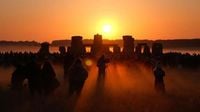As summer 2025 dawns, millions across the Northern Hemisphere prepare to welcome the longest day of the year. The summer solstice, arriving on Friday, June 20, 2025, marks the official start of astronomical summer and brings with it the most daylight hours of the year. This celestial event, steeped in science, tradition, and spiritual meaning, has been celebrated for thousands of years and continues to inspire awe and reflection today.
The summer solstice occurs when the Earth's axial tilt reaches its maximum angle toward the Sun, causing the Sun to appear at its highest point in the sky. In 2025, this moment will happen precisely at 10:42 p.m. Eastern Time (9:42 p.m. Central Time), according to NASA and the Old Farmer's Almanac. This tilt of approximately 23.4 degrees is responsible for the changing seasons, as it alters the amount and angle of sunlight different parts of the globe receive throughout the year.
On the solstice day, the Northern Hemisphere enjoys its longest stretch of daylight because the Sun travels its northernmost path across the sky. NASA explains that the Sun is directly over the Tropic of Cancer, situated at 23.5 degrees north latitude, creating extended daylight hours. Conversely, the Southern Hemisphere experiences its shortest day and longest night, marking its winter solstice; their summer solstice will occur six months later in December.
But why does the date of the summer solstice shift slightly each year? The answer lies in our calendar system. While a calendar year is 365 days, Earth actually takes about 365.25 days to orbit the Sun. This extra quarter day accumulates, necessitating a leap day every four years to keep our calendars aligned with Earth's position in its orbit. Consequently, the solstice can fall on June 20, 21, or 22. In 2025, it falls on June 20, a date that also marks the official beginning of summer for astronomers.
While meteorologists often define summer as June 1 through August 31, based on temperature patterns, astronomers mark summer’s start with the solstice and its end with the autumnal equinox in late September. This astronomical definition ties the seasons directly to Earth's orbit and axial tilt, highlighting the celestial mechanics behind what we experience as seasonal change.
Despite being the longest day, the summer solstice is not typically the hottest day of the year. Peak summer temperatures usually arrive weeks later, as land and water absorb and release heat over time. For example, in Louisville, Kentucky, the National Weather Service forecasts highs nearing 93 to 96 degrees Fahrenheit in the days following the solstice, with heat indices exceeding 100 due to humidity.
Beyond its scientific significance, the summer solstice carries deep cultural and spiritual meanings. The term “solstice” itself derives from the Latin “solstitium,” combining “sol” (sun) and “sistere” (to stand still), referring to the Sun’s apparent pause in its path across the sky. This moment of stillness has inspired countless traditions worldwide.
Ancient cultures such as the Druids, Native Americans, ancient Egyptians, and the Inca celebrated the solstice with ceremonies and rituals. Stonehenge in England is famously aligned with the sunrise on the summer solstice, allowing sunlight to stream through its monumental stones in a breathtaking display. In Egypt, the solstice was linked to the rising of the Nile and the goddess Isis, while the Inca honored the Sun god Inti during their Inti Raymi festival.
Modern celebrations often blend these ancestral rituals with contemporary practices. Many people use the solstice as a time for reflection, renewal, and setting intentions. Spiritual observers see it as a moment to honor light, vitality, and growth, symbolizing inner strength and abundance. Rituals may involve spending time outdoors at sunrise or sunset, breathing deeply, and repeating affirmations such as “I am light, I am abundance,” to align with the solar energy.
In Mexico and other parts of the Northern Hemisphere, the solstice is a moment of rebirth and spiritual renewal. Pre-Hispanic cultures celebrated the solstice at ceremonial sites like Chichen Itza, emphasizing the connection between celestial events and human life cycles. Today, many continue to honor this tradition by seeking mental clarity, emotional vitality, and creative inspiration during the solstice period.
For those unable to witness solstice events in person, organizations like English Heritage offer livestreams of the Stonehenge solstice celebrations. In 2025, the festivities will be broadcast starting at 8:00 p.m. British Summer Time on June 20, continuing through the early morning hours to capture the stunning sunrise at 4:52 a.m. GMT on June 21.
Interestingly, the solstice day does not always have the earliest sunrise or latest sunset. Due to Earth’s elliptical orbit and axial tilt, the earliest sunrises usually occur before the solstice, and the latest sunsets happen afterward. Still, the day boasts the greatest total hours of sunlight, which can be especially dramatic in northern regions. Near the Arctic Circle, the phenomenon of the midnight Sun means the sun remains visible for 24 hours around the solstice.
As we look ahead to the summer solstice of 2025, it’s clear that this astronomical event is much more than a marker of the seasons. It is a moment that connects us to the rhythms of the natural world, the mysteries of the cosmos, and the enduring human impulse to celebrate light and life. Whether through scientific curiosity, cultural tradition, or spiritual practice, the solstice invites everyone to pause, reflect, and bask in the sun’s full glory.






